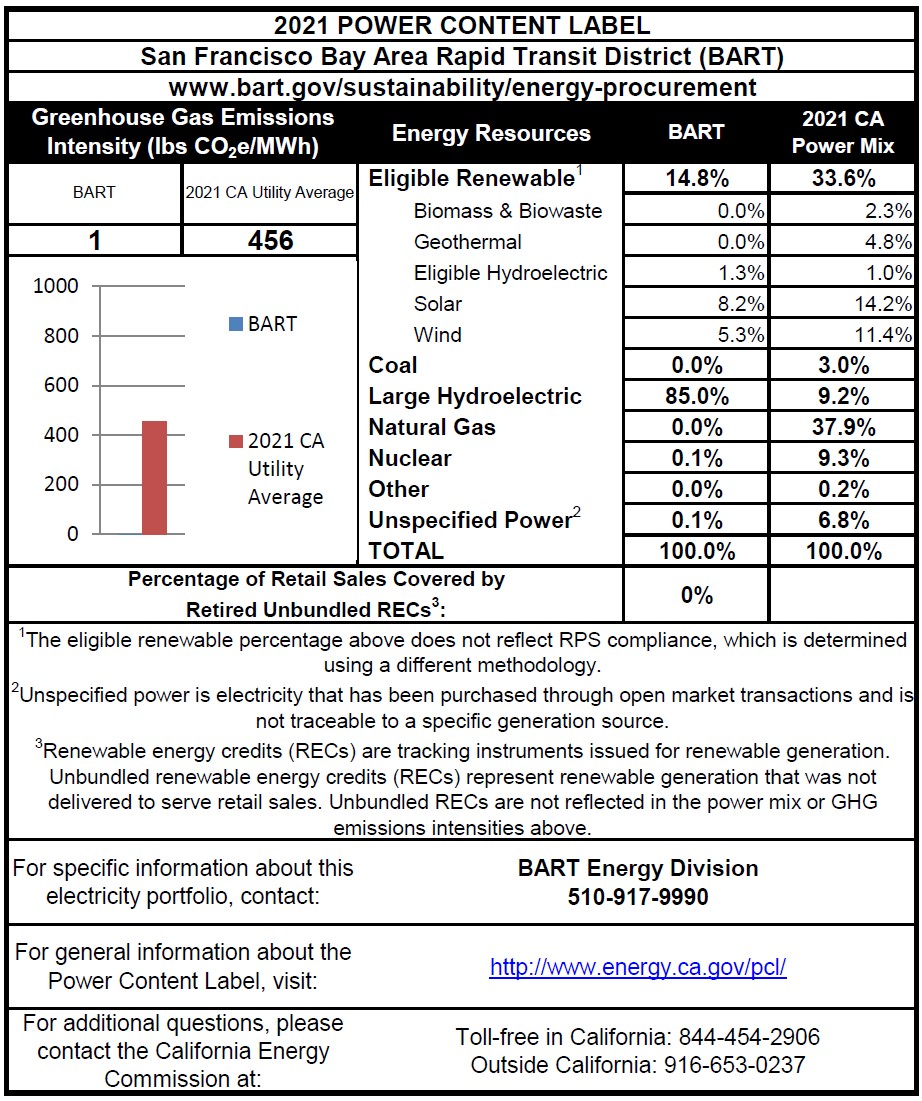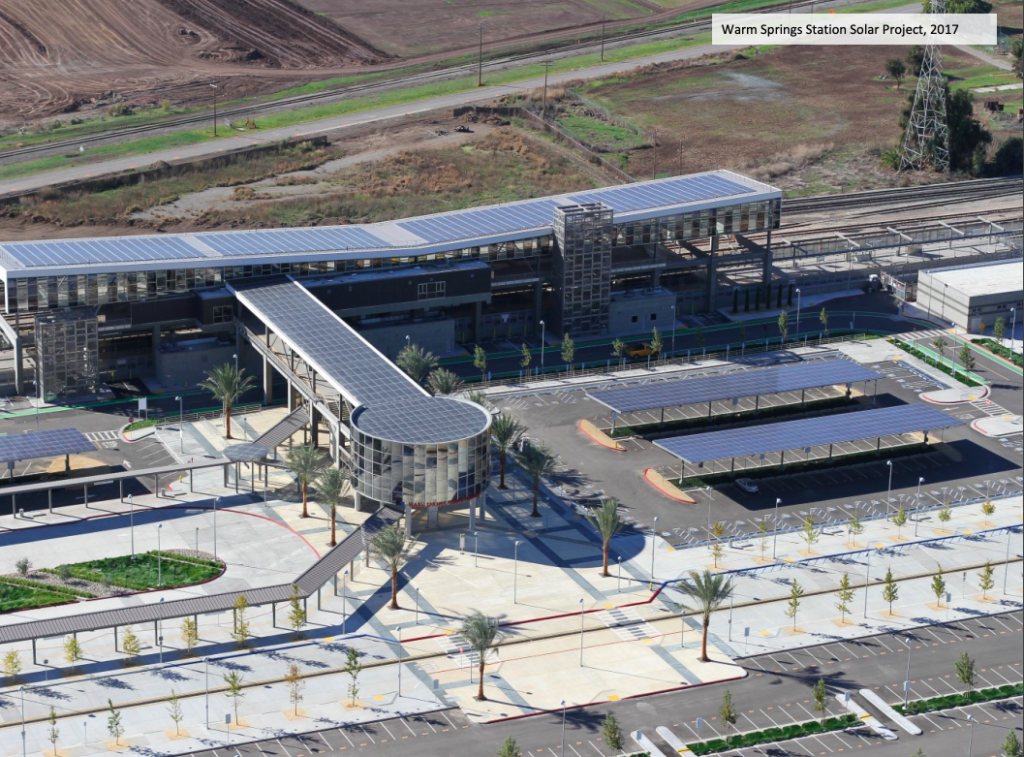
Photo: Warm Springs / South Fremont Station has nearly 2,000 solar panels installed on the station roof and on parking lot canopies.
Calendar Year 2023 Power Content Label
Each calendar year, BART’s power supply sources are inventoried and independently verified in its Power Content Label (PCL), produced under the California Energy Commission’s Power Source Disclosure (PSD) program.
In 2023, BART achieved a power supply that was 88% GHG-free while growing its total share of eligible renewable electricity to 66.8%. BART’s renewable power mix was comprised primarily of photovoltaic solar (35.5%) and wind (25.4%), supplemented by small hydroelectric resources (5.9%). Its remaining power was sourced from large hydroelectric generation (21.3%) and unspecified power purchased directly from the electric grid (11.9%).
Almost 60% of BART’s power was provided by its long-term Power Purchase Agreements with two renewable facilities: Slate Solar and Sky River Wind.
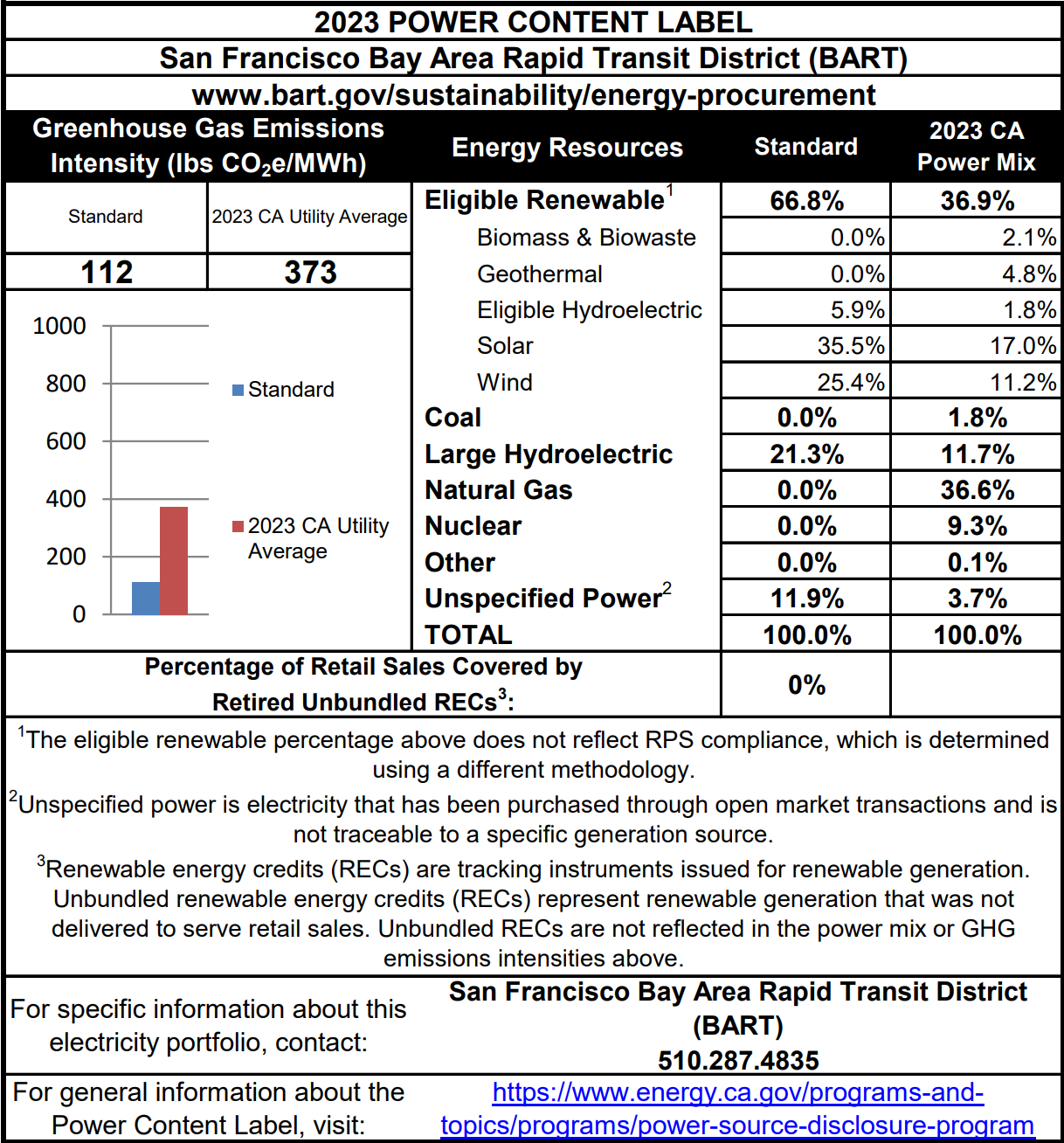
Calendar Year 2022 Power Content Label
Each calendar year, BART’s power supply sources are inventoried and independently verified in its Power Content Label (PCL), produced under the California Energy Commission’s Power Source Disclosure (PSD) program.
In 2022, BART achieved a power supply that was 100% GHG-free while growing its total share of eligible renewable electricity to approximately 61.5%. BART’s renewable power mix was comprised primarily of photovoltaic solar (36.9%) and wind (23.7%), supplemented by a contribution from small hydroelectric resources. Its remaining power (38.5%) was sourced from large hydroelectric generation.
This was the first full year of commercial operations for BART’s two new renewable power purchase agreements (PPAs), Slate Solar (50.5 MW) and Sky River Wind (30 MW), after both resources came online in late 2021. Together, these projects generated over half of BART’s electricity needs in 2022.

Calendar Year 2021 Power Content Label
Each calendar year, BART’s power supply sources are inventoried and independently verified in its Power Content Label (PCL), produced under the California Energy Commission’s Power Source Disclosure (PSD) program.
In 2021, BART maintained a power supply that was principally GHG-free while growing its total share of eligible renewable electricity to approximately 15%. BART’s power mix was comprised primarily (85%) of large hydroelectric generation, supplemented by substantial contributions from photovoltaic solar, wind, and small hydroelectric resources. Trace quantities of nuclear and unspecified generation are also represented due to modest deliveries of asset-controlling supplier power (“ACS power”) sourced from Tacoma Power in instances where specified hydroelectric capacity was unavailable.
Notably, 2021 saw the commencement of commercial operations for BART’s two new renewable power purchase agreements (PPAs), Slate Solar (50.5 MW), and Sky River Wind (30 MW). Together, these projects are expected to serve approximately 50% of the District’s annual electricity requirements beginning in 2022.
Calendar Year 2020 Power Content Label
In 2020, for the first time in its history, BART achieved a 100% greenhouse gas free (GHG-free) power supply as certified by its 2020 Power Content Label (PCL) produced under the California Energy Commission’s Power Source Disclosure program. Of BART’s total 2020 power supply, 95% was sourced from large hydroelectric sources, while the balance of its electric supply was generated by small hydroelectric and solar projects which qualify as renewable resources under California state law.
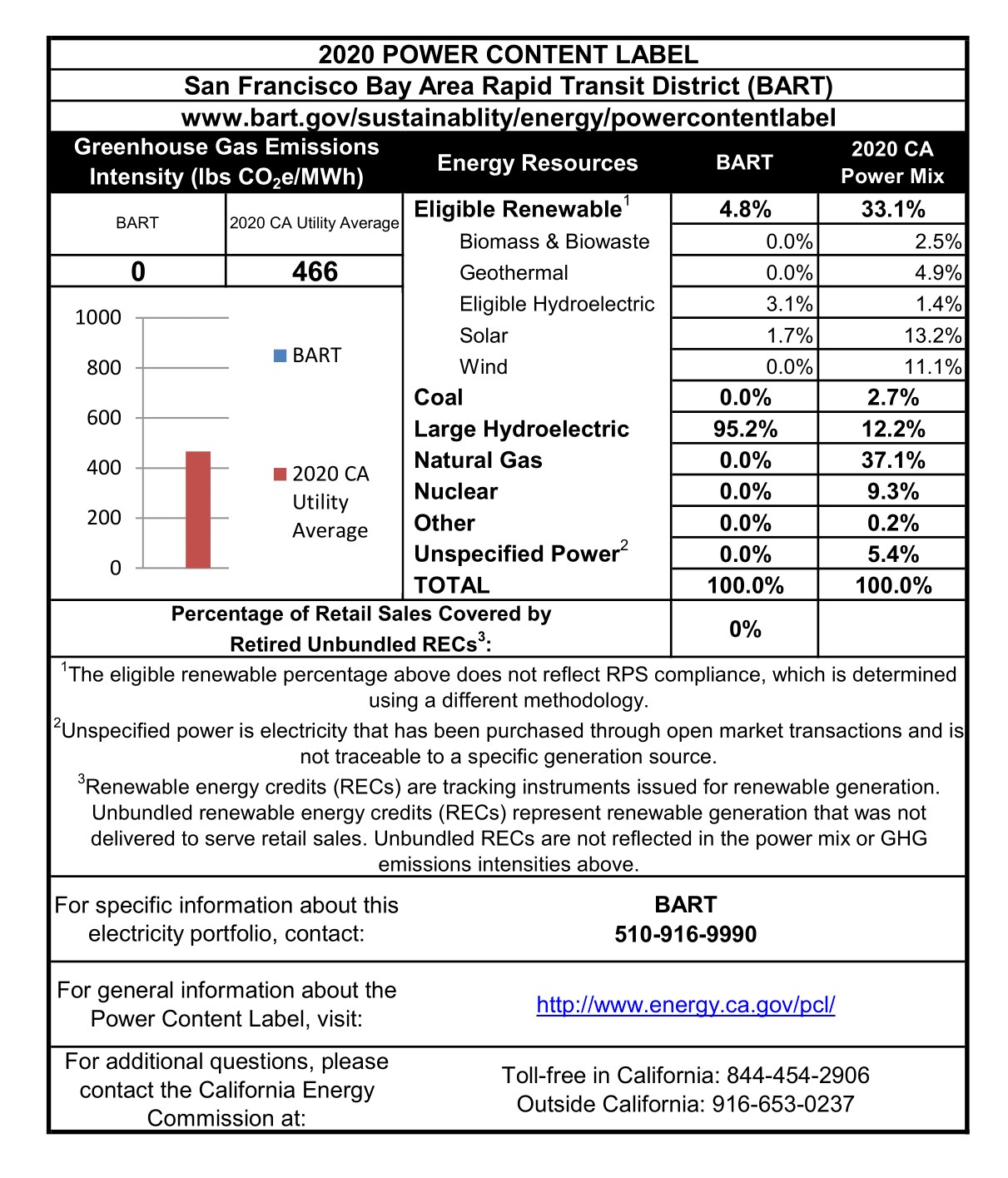
Moving forward, BART will focus on maintaining a power supply that is principally GHG-free while substantially increasing its overall share of renewable electricity. To support that objective, in 2021 BART will bring online two renewable power purchase agreements, one wind and one solar, which are collectively expected to serve upwards of 50% of the District’s annual electricity requirements beginning in 2022.
The PCL is an annual report produced under the California Energy Commission’s Power Source Disclosure program that provides a detailed inventory of BART’s power sources and how it compares to California’s “grid average” power mix. As a compliance requirement introduced under Assembly Bill 923 (2019), BART produces a PCL annually to enhance the transparency of its power supply portfolio, despite not serving retail load like all other program participants. The PCL is released each fall for the prior calendar year.
Calendar Year 2019 Power Content Label
The Power Content Label (PCL) is an annual report produced under the California Energy Commission’s Power Source Disclosure program that provides a detailed view into BART’s sources of power supply and how it compares to California’s “grid average” power mix. As a compliance obligation introduced under Assembly Bill 923 (2019), BART produces a PCL annually to enhance the transparency of its power supply portfolio, despite not serving retail load like all other program participants. The PCL is released each fall for the prior calendar year. BART’s first ever PCL profiles its 2019 electric portfolio.
In 2019, 92% of BART’s power supply was sourced from greenhouse gas free (“GHG-free”) energy sources including 5% from eligible renewable resources. [1] Large hydroelectric resources represented BART’s largest source of GHG-free electricity, but are not defined as eligible renewable resources under California state law. In California, bioenergy, geothermal, solar photovoltaic, solar thermal, small hydroelectric, and wind energy resources are all designated as eligible renewable resources under California’s Renewables Portfolio Standard (RPS).
In 2019, BART’s electric power portfolio was comprised of specified imports including large hydroelectric and ACS power sourced from the Pacific Northwest, federal preference hydroelectric power from Western Area Power Administration (WAPA), renewable hydroelectric power generated by the Lake Nacimiento hydroelectric project, and photovoltaic solar power from the Gridley #2 solar project and other onsite solar projects located on BART property.
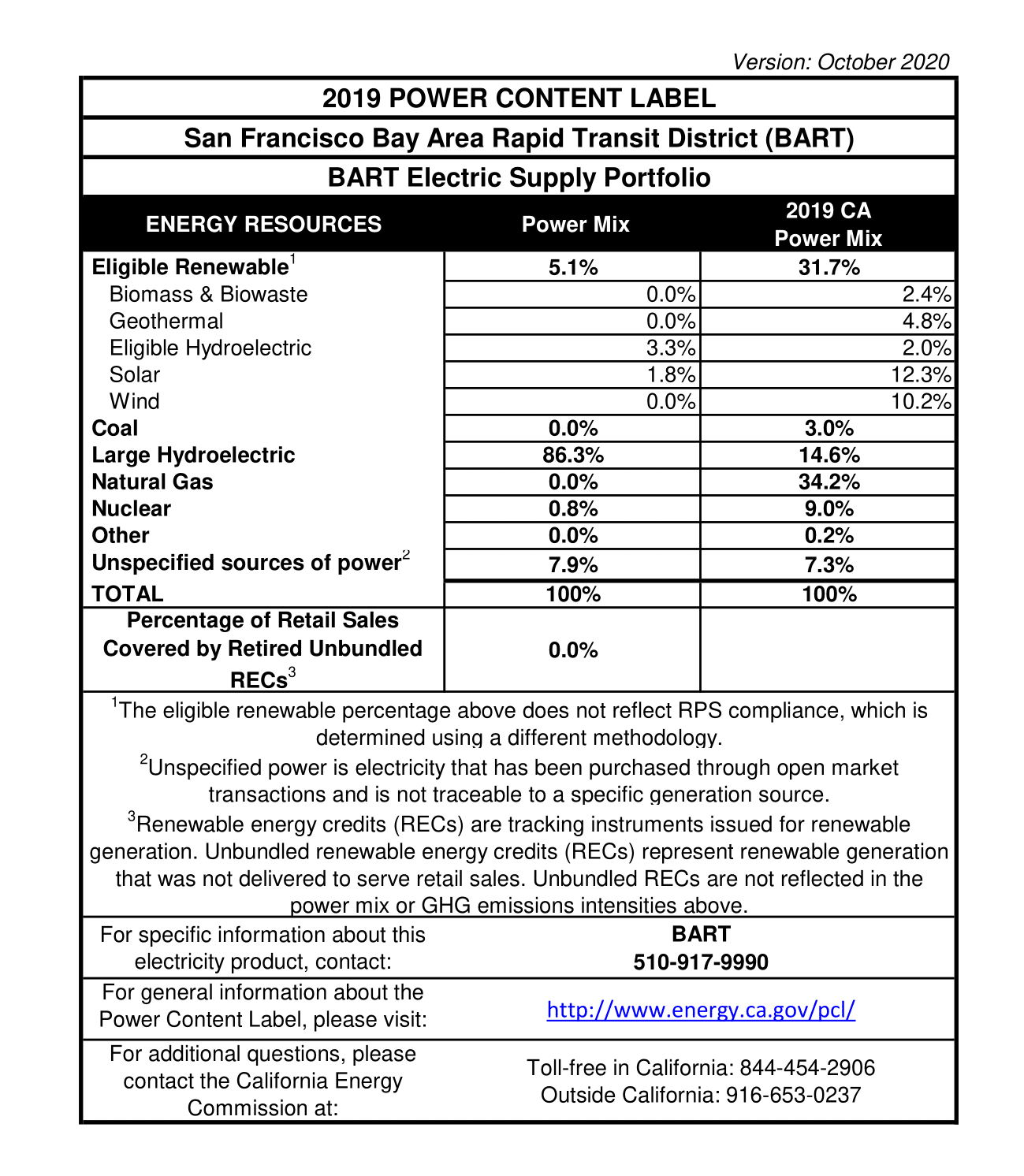
[1] “Eligible renewable resources” refer to electric supply resources that qualify as renewable pursuant to the California Renewables Portfolio Standard (RPS) program.
